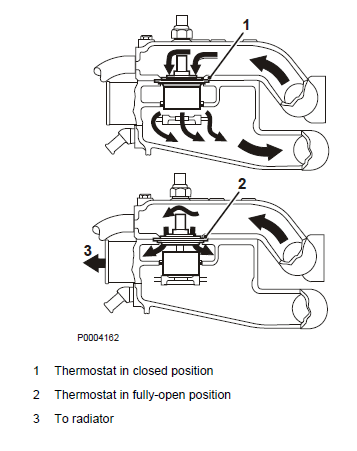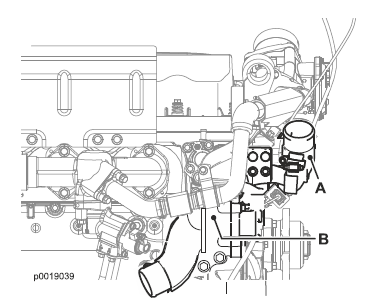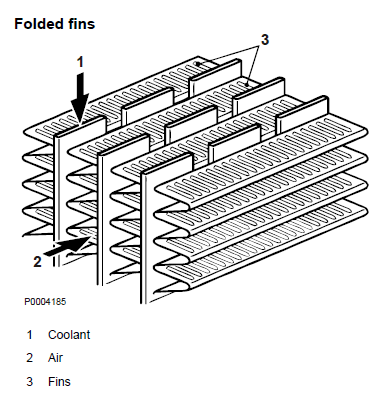Cavitation of Volvo Diesel Engine
Pump suction capacity depends on coolant pressure and temperature. An increase in coolant temperature reduces suction capacity. In order to avoid cavitation there must be a static pressure on the suction side of the pump. To achieve this there must be a hose from the expansion tank to the suction side of the pump. Cavitation occurs when static coolant pressure inside the pump falls to coolant vapor pressure. Some of the coolant then vaporizes and vapor bubbles are formed. These vapor bubbles follow the coolant a little way and when they reach an area in the pump with higher pressure they implode. A pressure pulse is formed at every implosion and if this is repeated often enough mechanical damage to pump materials may occur (above all to the impeller). At the same time, pump performance is impaired.
Thermostat
A thermostat is installed in the cooling system to maintain coolant temperature within a certain temperature range. The cooling system comprises an inner circuit and an outer circuit through the radiator. The thermostat is closed when the engine is cold and during the warm-up period. All coolant circulates in the internal circuit in order for the engine to reach the correct operating temperature as quickly as possible. When the coolant reaches thermostat opening temperature it begins to circulate through the external circuit. The thermostat controls coolant flow to the radiator and thus maintains coolant temperature at the correct level for different engine loads.

These cooling system differences have no influence on external cooling system design. The thermostat opens fully at extreme engine loads and high ambient temperatures. The internal coolant system is then fully isolated and coolant circulates through the radiator.
NOTICE! If the thermostat is removed, the following will happen:
• The warm-up period the engine requires to reach operating temperature will be much longer. Furthermore, the engine will not reach operating temperature at idle or low to medium loads at moderate ambient temperatures.
• Engine lubricating oil temperature will not reach the correct level, which increases fuel consumption.
Exhaust emissions will increase (more white smoke) and engine power will be reduced a little. It will also increase engine wear and shorten engine operating life.
• System cooling capacity will also be impaired as not all coolant will pass through the radiator (uncontrolled coolant flow).
Even if the temperature gauge shows the correct coolant temperature the coolant may boil in the engine water jacket.
• Engines that are operated without a thermostat are not covered by warranty.
Example
TAD1370 thermostat position at increased coolant capacity to the retarder cooler.
The thermostat location is moved if increased coolant capacity to the retarder cooler is selected. This unit may only be ordered as an option when ordering a new engine.

The thermostat is moved from location A (original position) to the new unit B. The original position A then has no thermostat.
Radiator
The radiator is a coolant-to-air type heat exchanger and forms part of both the coolant and cooling air systems. Hot coolant from the engine passes through the radiator pipes and is cooled by cooling air with the aid of a fan. The radiator must have external dimensions that are as small as possible, but still have good cooling capacity and small pressure drops on the air and coolant sides. The radiator core may not be too compact in extremely dusty conditions, as it may become clogged.
Heat from the coolant must be transferred to air through the radiator tube core. The heat transfer coefficient is much higher on the coolant side than on the air side and therefore the contact surface between the air and the tubes must be enlarged by means of fins. The radiator comprises an upper and lower tank, coolant tubes, fins and a frame.
Volvo Penta uses aluminum radiators:
The gills on the fins increase the heat transfer coefficient further.
The following factors are important when selecting a radiator:
- Engine heat transfer to coolant.
- Heat transfer from accessory components (e.g. torque converter oil cooler) to coolant.
- The maximum temperature of the air entering the radiator.
- Maximum coolant temperature at the radiator inlet
- Cooling air flow and direction (puller and pusher fans).
- The pressure drop on the coolant side.
- The pressure drop on the cooling air side.
- Radiator core surface area.
- Vane type and vane interval.
- The amount of dust and foreign particles in cooling air.
- The ease with which it can be damaged and the type of guard that may be used.
Cooling capacity may be significantly impaired if dust lodges on the fins. It is therefore important to clean the radiator often in dusty environments. Because of this the design must be such that the radiator is easily accessible and easy to clean. High pressure washers may be used on tube-and-folded-fin type radiators, but pressure must be reduced for tube-and-flat-fin radiators so that the fins are not deformed. If dust is firmly lodged or mixed with oil, a solvent may be used. The recommended fin interval depends on the type of dust that occurs and how often the radiator is cleaned. The most difficult environments are in agricultural and forestry applications. If fin intervals are too small the radiator must be cleaned very often. A fin interval of around 4 mm (0.157") and fins without grilles are recommended for such applications. A larger radiator surface area is required to compensate for the greater fin interval.

Pipes and hoses
Pipes and hoses must be designed to provide good coolant flow. Sharp bends, pinched surfaces, sharp edges and sudden changes of location must be avoided as they may cause large pressure drops. The hoses must withstand coolant temperatures and pressures, and be resistant to ethylene glycol and anti-corrosion additives. Outside hose surfaces must be resistant to fuel and lubricating oil. The hoses must be reinforced, preferably with EPDM rubber or silicone rubber. Pipe and hose recommendations:
- Only use hoses with smooth inside surfaces. Internally folded, flexible hoses may not be used as they cause large pressure drops.
- The internal hose diameter must be slightly smaller than the connection pipe external diameter.
- All pipe ends connected to hoses must have flanges to improve sealing.
- Radiator connections may not have smaller diameters than engine pipes.
Engine oil cooler
The engine oil cooler is connected in parallel to the engine cooling circuit. It is engine mounted; Volvo Penta uses two different types:
- Plate oil coolers.
- Tube oil coolers.
For More Volvo Engine workshop information, please visit
Cooling Water System of Volvo Diesel Engine
Volvo Engine Mountings for Mobile Installation
Copyright © Guangxi Dingbo Generator Set Manufacturing Co., Ltd. All Rights Reserved | Sitemap
Update cookies preferences